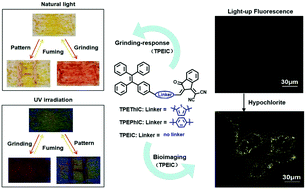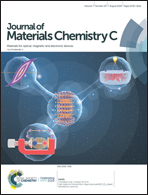Donor–acceptor type aggregation-induced emission luminophores based on the 1,1-dicyanomethylene-3-indanone unit for bridge-dependent reversible mechanochromism and light-up biosensing of hypochlorites†
Abstract
Three donor–acceptor type AIE-active molecules, TPEThIC, TPEPhIC and TPEIC, with the same tetraphenylethene and 1,1-dicyanomethylene-3-indanone (IC) units but with different spacers, namely, a thiophene ring, benzene ring and direct single bond between TPE and IC units, were designed and synthesized. The modulation of these spacers caused variations in electron cloud distribution, spatial conformation and molecular packing architecture, resulting in the distinctions of photophysical properties, response towards external mechanical grinding and the fluorescence sensing of hypochlorite. In terms of red-shift AIE emission, TPEIC with a more twisted conformation possessed a higher relative intensity (I/I0) than the others in THF–H2O mixture. Moreover, the modification of the π-conjugated spacer provided molecules with inverse mechano-responsive behaviors, where TPEIC and TPEPhIC exhibited a 117 nm red-shift in emission and a 29 nm blue-shift in emission, respectively. In addition, based on the IC moiety as a hypochlorite (ClO−) receptor, the three molecules were qualified for the light-up fluorescence sensing of ClO− with obvious visible color changes. The biosensing of endogenous ClO− based on the better detection performance of the TPEIC probe was achieved in HeLa cells. These results demonstrate the great potential of IC as a strong electron-deficient unit for designing donor–acceptor type mechano-responsive materials and light-up biosensors for the detection of hypochlorite in living cells.



 Please wait while we load your content...
Please wait while we load your content...